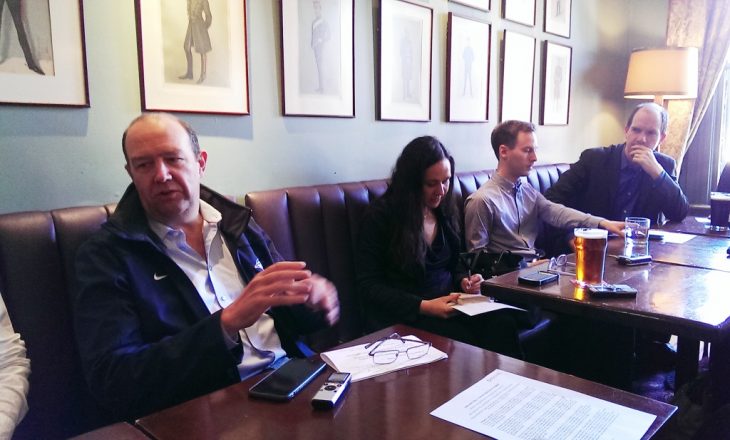
TORONTO – Guy Laurence insists he’s merely in the foothills of a long climb, pulling along with him the Rogers Communications brand.
He’s surely been active in his 15 months as Rogers CEO (Can it only be 15 months? So much has been done.) Since the announcement back in September 2013 that he would be the new CEO (Laurence officially started December 2 that year), Rogers purchased the national NHL rights in a $5.2 billion, 12-year deal; spent another $3.3 billion on wireless spectrum; unveiled a new Rogers 3.0 plan that is driving the restructuring of the company; pledged to do everything in his power to improve customer service (and it’s starting to pay off); cut several hundred middle managers; reached way outside the company for new leadership; launched streaming video service shomi with Shaw Communications; signed a partner market agreement with Vodafone, his former employer; unveiled a raft of new NHL content consumption apps with various embedded doo-dads; bought Source Cable; launched LTE-Advanced; announced a $100-million partnership with Vice Media (the Toronto studio is nearing completion); committed to and made sure to publish a transparency report showing what he can about what the police and government is asking of Rogers; overhauled U.S. roaming with its $5/day Roam Like Home plan; and then Friday extended that plan to 35 European countries for $10/day.
The man was brought in by the Rogers family and board of directors to change things and he has not held back. Even the company’s logo has been overhauled, unveiled earlier this month with a sleeker look, a bit of a different  red (compare it to the Canadian flag to wee what it was switched to…) and the Rogers Mobius strip now appears to roll left-to-right, or forward.
red (compare it to the Canadian flag to wee what it was switched to…) and the Rogers Mobius strip now appears to roll left-to-right, or forward.
Laurence seems most pleased about the new roaming plans because out of all the complaints he has heard from customers, the high costs of roaming came second only to the fact customers can’t understand their own bills (something else the company is working to fix, he says). After announcing the new Roam Like Home European plan to reporters Friday, Laurence stuck around for over an hour at The Oxley Pub in downtown Toronto, answering – even encouraging –reporters questions. Engaging and funny with the bunch of us, his public persona is quite unlike many other Canadian CEOs.
He was blunt when asked by a reporter how long it’s going to take to “fix” the Rogers brand and get people to start thinking of the company as a paragon of customer service and not a pariah. It’s going to take a while.
“But it’s kind of like the classic thing of how do you eat an elephant? One bite at a time.” – Guy Laurence
It’s a long road to changing how people think, when their feelings are so well entrenched in a certain direction, Laurence said. But, “at a certain point (changes) reach your consciousness and you start to reframe your view of a particular brand. Then, eventually, you get to a point where you’re comfortable with that brand and you start talking to other people about that brand and you become an advocate. That process takes years,” he explained. “But it’s kind of like the classic thing of how do you eat an elephant? One bite at a time.”
Laurence says he is driving his people pretty hard to meet their deadlines and deliverables so that things do improve as quickly as possible – and he noted in the latest Commissioner for Complaints for Telecommunications Services report that Rogers results had improved by a third. “We’re not the best, but that’s okay. We’ll get there… it’s going to take a long time.”
Part of the change inside the company also involved bringing in some new blood from outside the Rogers walls. While there were some internal promotions (Dale Hooper to CMO and Jamie Williams to CIO, for example), Laurence hired Jacob Glick and Deepak Khandelwal away from Google to be chief corporate officer and chief customer officer, respectively; Cisco’s Nitin Kawale as president of its enterprise business unit; and Dirk Woessner from Deutsche Telecom to be president of its consumer business unit.
“I wanted people who were more in tune with the digital world,” Laurence said. “You take Jacob Glick, ex-head of public policy globally for Google. You take a Deepak, head of customer care for Google globally, handling call centers in 100 countries in 43 languages. They’re used to doing business in a different way to the traditional way.
“Dirk Woessner was from Deutsche Telecom (and) comes from a heavily regulated environment in Germany. Deutsche Telecom have outperformed Vodafone, my old company… for the last 10 straight quarters. So, what I wanted is people who are firmly focused on the new digital world and all that broadest sense and people who wanted to win.”
It’s a mix of insiders and newcomers, he added. “Our new chief brand officer, Dale Hooper came over from the media team. I don’t know what you think, but I think we’re advertising a lot better than the crap we used to produce a year ago,” Laurence added. “And Jamie Williams, who just got appointed last week as CIO is a very experienced IT guy… very good at cyber security. Customer protection of data is his specialty.
“To me, it was just about finding the right management team that blended a digital way of thinking, if you like, a very modern way of thinking.” – Laurence
“To me, it was just about finding the right management team that blended a digital way of thinking, if you like, a very modern way of thinking, with knowledge of Canada… and lots of experience from other industries. Industries that are considered progressive.
Some of the reporters also noted Rogers’ much more sanguine responses to recent government and CRTC policy moves than it had shown in the past – and which stand in stark contrast to the reactions of its biggest competitor, Bell Canada.
“We were, I would say, fairly pleased with the majority of the CRTC decisions,” Laurence said. “We’ve felt that they reflected the current mood of the public and we felt that we could embrace them.” The company has an internal Let’s Talk TV team which is now working through the whole of the CRTC TV Policy Review to decide what the company will do in the marketplace that satisfies the new rules and makes customers happy.
“Since we think they’re good for customers, then we think it’s in our interests to get them out as soon as possible, but we’re talking literally quarters of time because of the complexity – the IT systems were set up 30 years ago on an industry model which is now not relevant, and therefore it’s a big change,” he explained.
As for the recent public tussles the TV and telecom industry have had with both the CRTC and the federal government over the past 24-36 months on TV and wireless? A thing of the past for Rogers, at least.
“My approach is they have a job to do and we have a job to do and we need to sit down like adults and discuss it,” said Laurence. “The CRTC raised some valid points and I think we have some valid points – and a lot of the judgments you’ve seen coming out recently are the result of well-argued points of view by adults in a non-confrontational way that are resulting in pragmatic announcements that benefit the consumer. And surely that’s how it should be.
“Corporations should not get everything they want and regulators should not get in the way of funding or helping companies that are capital intensive like us to develop our business.” – Laurence
“In other words, corporations should not get everything they want and regulators should not get in the way of funding or helping companies that are capital intensive like us to develop our business. And that’s a gray zone, it’s not black or white. Maybe it veered left or too far right. My view right now at CRTC is that it is balanced. Does it mean to say that on the next issue we talked to them about that it will be balanced? I don’t know, but I go in with the approach that we are all adults, we should be able to sort something out.”
One of the messages Laurence has often repeated and likely wishes had more legs in public forums is that the Canadian wireless market is actually very competitive. The federal government wanted and got a fourth carrier but Laurence hopes the politicians also realize what it takes to build and maintain communications networks in Canada – and to let investors expect a decent return from that risk-taking. “I invest $49 million a day in my networks, in new technologies, most of which are totally invisible to you,” he told reporters. “But we keep doing it and we can only do it if we have the confidence we’re going to get a return on our investment.”
And winning competitively, cautioned Laurence, isn’t about a focus on your competitors.
“Everyone thinks it’s all about what we do against our competitors. It’s all about what we do for our customers – and as a consequence of doing the right thing for your customer, you do better than your competitor… I don’t wake up worrying about Bell. I wake up in the morning worrying about my customers.
“92,000 customers in Canada change their contracts every week. You can’t tell me it’s not a competitive market if 92,000 people change their plan in a week. How many other markets do you know – how many other industries in Canada do you know where 92,000 people change their supplier every week?”



